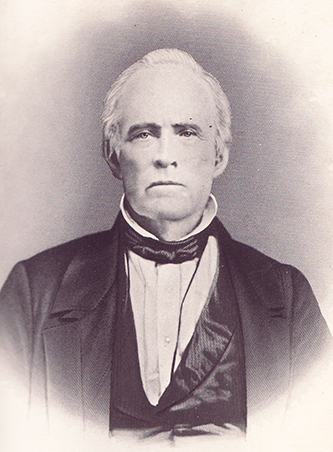Hawkins, John Davis
15 Apr. 1781–5 Dec. 1858
John Davis Hawkins, lawyer, legislator, and planter, was born at Pleasant Hill plantation in Granville (now Vance) County, the fourth of twelve children of Philemon Hawkins III and Lucy Davis. He was a grandson of Colonel Philemon Hawkins, Sr., who was aide-de-camp to Governor William Tryon at the Battle of Alamance in 1771 and held a colonel's commission in the American Revolution. John's brother, William Hawkins, was governor of North Carolina during the War of 1812.
Hawkins was graduated from The University of North Carolina in 1801 and became a lawyer. At an early age he was made a trustee of the university, a position he held for fifty-one years. He was a member of the Episcopal church.
It has been said that Hawkins "possessed rare and extraordinary qualities—a man of great willpower and force of character, intelligent and influential." He represented Franklin County in the House of Commons in 1821–22 and 1834–35, and in the senate for three terms between 1836 and 1841. For many years he also served as a county judge. In private life, Hawkins was a planter of some magnitude and invested a portion of his wealth in the development of early railroads, particularly the Raleigh and Gaston Railroad.
In 1803, he married Jane Boyd, daughter of Alexander and Ann Swepson Boyd of Boydton, Va. They had thirteen children, born between 1805 and 1827. Hawkins was buried in Oakwood Cemetery, Raleigh.
References:
Samuel A. Ashe, ed., Biographical History of North Carolina, vol. 5 (1906).
John L. Cheney, Jr., ed., North Carolina Government, 1585–1974 (1975).
Additional Resources:
Hawkins Family Papers, 1738-1895 (collection no. 00322). The Southern Historical Collection. Louis Round Wilson Special Collections Library. University of North Carolina at Chapel Hill. http://www2.lib.unc.edu/mss/inv/h/Hawkins_Family.html (accessed April 11, 2014).
United States Department of the Interior. National Park Service. National Register of Historic Places Inventory - Nomination Form: Pleasant Hill/Rivenoak/Hawkins House. By Catherine W. Bishir and Jim Sumner, Raleigh, N.C. January 11, 1979. http://www.hpo.ncdcr.gov/nr/VN0008.pdf (accessed April 11, 2014).
Charlotte Hawkins Brown & Palmer Memorial Institute: What One Young African American Woman Could Do. UNC Press Books, 1999. http://books.google.com/books?id=RC0wj1YRuOoC&pg=PA14#v=onepage&q&f=false (accessed April 11, 2014).
"Original Art, Accession #: H.19XX.135.203." 1835-1845. North Carolina Museum of History. (accessed April 11, 2014).
Image Credits:
E. G. Williams and Bro., engraver "Jno. D. Hawkins." Engraving. Biographical history of North Carolina from colonial times to the present volume 5. Greensboro, N.C.: C.L. Van Noppen. 1906. 160.
1 January 1988 | Maupin, Armistead J.
 John Davis Hawkins, lawyer, legislator, and planter, was born at Pleasant Hill plantation in
John Davis Hawkins, lawyer, legislator, and planter, was born at Pleasant Hill plantation in